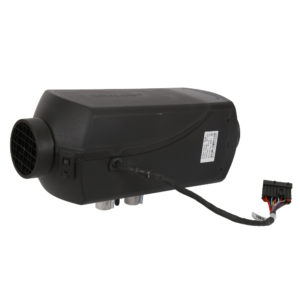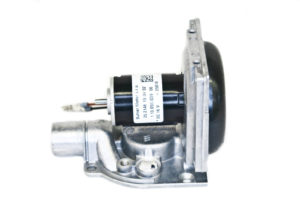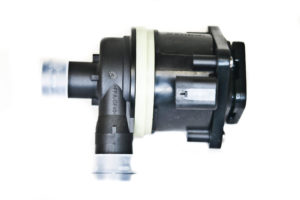Fuel-fired heaters keep your machines running and workers comfortable.
These units are critical for industrial process facilities and are terrific to have in heavy duty construction industries. Other applications include trucks, off-highway equipment, boats and buses.
Fuel-fired heaters are insulated enclosures that transfer heat through the combustion of fuel, heating fluids contained inside coils. Heater and coil configuration combinations differ depending on the industry you work in plus the application and heater design. Polar Mobility has fuel-fired heaters that are easy to install, EPA verified and CARB compliant for North America with built-in self-diagnostics.
There are 3 types of fuel-fired heaters.
Hydronic/Liquid Coolant: Fluid is circulated and heated for remote heating. Do you need to warm your engine before you get into the cab? Are you carrying perishable goods that need to be heated? Hydronic/liquid coolant fuel-fired heaters are the solution for you.
Diesel Fuel or Gasoline for Fuel Source: This type of fuel-fired heater uses fuel from the equipment as the energy source. No need to keep your vehicle idling as these units draw power from the vehicle itself.
Air Heaters: This fuel-fired heater works like the Hydronic/Liquid Coolant type in that it circulates and heats fluid for remote heating but it uses air instead of liquid. Heated air must be void of combustion-by-products like carbon monoxide (CO) and carbon dioxide (CO2).
How do Fuel-Fired heaters work?
Fuel-fired heaters essentially are made up of tubes, burners, refractory-lined box and a stack. The burner arrangement is the installation location and orientation of the burners. Burners can be put in floors, walls or roofs of the radiant section (cylinder, cabin or box shape).
Burners can be upfired, sidefired or downfired. If they are end wall fired they burn horizontally across the radiant’s length. Side wall fired, on the other hand, means the heater burns direct flames across the radiant section’s width. There are also direct and indirect fuel-fired heaters.
Direct Fuel-Fired Heaters:
Air is forced through a gas flame. The flame comes into direct contact with the heat and air.
Advantages
- Saves fuel amount as space gets heated quickly
- Saves you time and money in installation since they are easy to move and adjust
- There are few moving parts making maintenance levels low
- Are you without electricity? A direct fuel-fired heater is great for this kind of environment since a convection heater with no blower or thermostat is used without any electrical outlet
Indirect Fuel-Fired Heaters:
The heat exchanger is heated by the flame contained in the burn chamber. Cooler air passes over and around this exchanger to heat the air.
Advantages
- Do you work on a site with lots of mould? An indirect fuel-fired heater is ideal for this environment due to the dryness of the heated air
- Great for small indoor spaces because minimal CO2 is emitted into the air and reduces risks of humidity buildup
- 100% clean air as the air circulating does not come into direct contact with the flame
Fuel-fired heaters are ideal for cold weather conditions. Your workers will stay happy in a warm environment and you will be able to continue your workday without machines failing. Ask our friendly staff at Polar Mobility which kind of fuel-fired heater is right for your business or application.
Practical Applications Across Industries
Mining: Temperatures can plummet deep within mines, making worker and machinery maintenance a top priority. Fuel-fired heaters can keep machinery working optimally and make workers comfortable during their shifts.
Heavy Construction: Working outdoors during Canadian winters can be challenging for heavy construction workers. Fuel-fired heaters can help ease the cold and keep construction machinery running, so the cold doesn’t have to be a reason for downtime.
Trucking: Cargo temperature requirements can be difficult to achieve as a long-haul truck driver, and fuel-fired heaters can keep perishables at proper temperatures so waste is avoided.
Maintenance and Support
Fuel-fired heaters are designed and built to achieve durability and longevity. Still, preventative maintenance can help maintain peak performance and address any issues before they cause the heater to break down. Polar Mobility offers comprehensive support, from installation to routine check-ups, ensuring your heaters remain in top shape.
Innovation at the Forefront
Polar Mobility is committed to continual research and development, ensuring that the fuel-fired heaters of tomorrow are even more efficient, durable, and versatile because as industries evolve, so does the need for heating solutions.
Fuel-fired heaters protect against the harsh cold on job sites, ensuring workers remain comfortable and machines operate efficiently. Our team at Polar Mobility is always ready to guide you on the best type of fuel-fired heater for your specific needs.
Frequently Asked Questions
Fuel-fired heaters are essential for keeping machinery operational and workers comfortable in industrial process facilities and heavy-duty construction industries. They are also used in trucks, off-highway equipment, boats, and buses.
Polar Mobility proudly carries Espar & Eberspächer Heaters and PROHEAT Dometic units. If you can’t find what you’re looking for in our catalogue, give us a call, and we can help customize a solution for your specific equipment or vehicle.
Fuel-fired heaters transfer heat through fuel combustion, heating fluids inside coils. They consist of tubes, burners, a refractory-lined box, and a stack with burners that can be installed in various orientations.
There are three kinds of fuel-fired heaters: Hydronic/Liquid Coolant heaters for remote heating of fluids, Diesel Fuel or Gasoline heaters that use fuel from the equipment, and Air Heaters that circulate and heat air for remote heating.
Direct fuel-fired heaters save fuel and time as they heat spaces quickly, are easy to install and move, have low maintenance levels, and can be used without electricity, making them suitable for environments without electrical outlets.
Due to the dryness of the heated air, indirect fuel-fired heaters are ideal for environments with mould. They are also great for small indoor spaces with minimal CO2 emissions and provide 100% clean air since the air does not come into direct contact with the flame.
Fuel-fired heaters ensure that workers remain comfortable in warm environments and prevent machinery from failing, allowing work to continue without interruptions due to cold weather.
Preventative maintenance is crucial for fuel-fired heaters to maintain peak performance and prevent unexpected breakdowns. At Polar Mobility, we provide full-spectrum support, from professional installation to regular maintenance check-ups, ensuring your heaters are always in optimal working condition. Our commitment to innovation ensures that we are continuously improving our heating solutions. We continually research and develop new technologies, making our fuel-fired heaters more efficient, durable, and adaptable to meet evolving industry demands.
Fuel-Fired Heating Units/Parts
Polar Mobility stocks and manufactures several fuel-fired heating units and parts to solve your heating problems!
Can’t find it? We’ll manufacture it to your specific needs. Contact us today!








-300x200.jpg)




